
Spanish postcard. Photo: Itala-Film. Pina Menichelli and Febo Mari in Il Fuoco/The Fire (Giovanni Pastrone, 1915). Collection: Marlene Pilaete. Please note that Menichelli wears her famous owl headwear here.

Italian postcard, no. 113.

Italian postcard by IPA CT Duplex. Photo: Film Società Anonima Ambrosio, Torino. Febo Mari in the title role in Attila (Febo Mari, 1918). Caption: Attila orders to kill all of the prisoners.
High-standing theatre company
Febo Mari was born in Messina, Sicily in 1881, as Alfredo Giovanni Leopoldo Rodriguez. His parents were Giovanni Rodriguez and Teresa Spadaro, and the Rodriguez family had Spanish aristocratic roots. When he was 14 he arranged with friends an improvised theatre school and wrote his first play. His parents considered it children’s play and let him be, as long as he continued his school.
Following his parents’ wishes, Alfredo Rodriguez studied and obtained his degree in Humanities, after which he moved to Milan to start working as a theatre critic for a Milanese journal. Soon however, he decided to change jobs and debuted on stage himself.
As a young actor, he started to work with various acclaimed theatre companies, such as those of Virginia Reiter and Ferruccio Fumagalli. In 1911, he took over the direction of the Compagnia del Teatro Manzoni. One year after he became a member of the high-standing theatre company of Marco Praga, with Tina Di Lorenzo and Armando Falconi as the leading actors.
This theatre company was financed by Giuseppe Visconti, father of the future stage and screen director Luchino Visconti. In 1911, Arturo Ambrosio also let him make his screen debut in the film L’innocente/The Innocent (1911), an adaptation of the novel by Gabriele D’Annunzio.
In 1912 he directed his first film at the Ambrosio studio, Il critic/The Critic, starring Mari himself and Fernanda Negri Pouget.

Old, faded photocard, reproducing a still from the diva film Il Fuoco (Giovanni Pastrone, 1915), starring Pina Menichelli and Febo Mari. Photo: Itala Film. Probably produced for the Iris Cinema in Cairo, Egypt. The cinema opened in 1912 as Teatro Iris and was situated on 13 rue Rosette, in Alexandria. Around 1915, it was one of the five main cinemas of Alexandria, having a capacity of 1000 people. In 1925, it was reinaugurated. It was titled Cinema Fouad later on, just like rue Rosette became Fouad Street. The top and bottom of the card seem to have been cut off, so possibly this card stems from an album. The card represents the moment the aristocratic lady inspires the painter to make his masterpiece.

Spanish postcard by Edics. y Publics. de Arte, L. Planas, Barcelona. Photo: Itala Film. Pina Menichelli and Febo Mari in a dramatic scene of Il fuoco/The Fire (Giovanni Pastrone, 1915). The film was released in Spain as El fuego.

Italian postcard, no. 3593. Photo: Vettori.
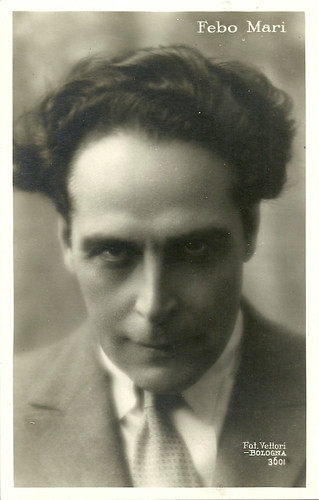
Italian postcard, no. 3601. Photo: Vettori.
Do it! It is beautiful!
In 1912, Febo Mari passed over to the Itala company, led by producer-director Giovanni Pastrone. He first acted opposite ‘monstre sacré’ of the stage Ermete Zacconi in Padre/Father (Dante Testa, Gino Zaccaria, 1912). He had the supporting part of the son of the enemy of Zacconi’s character, Vivanti, in love with Vivanti’s daughter.
Later, he appeared opposite the new Itala diva Pina Menichelli in Il fuoco/The Fire (Giovanni Pastrone, 1915) and Tigre reale (Giovanni Pastrone, 1916). Il fuoco was co-scripted by Mari with Pastrone and has nothing to do with Gabriele D’Annunzio’s novel, despite Spanish Wikipedia telling so.
Mari had the male lead in Il fuoco/The Fire (Giovanni Pastrone, 1915) as a poor painter who falls in love with a rich femme fatale (Menichelli) and follows her to her castle. He paints her portrait, which becomes a success, but she drugs and flees him when her husband returns. When afterwards she refuses to recognise the desperate artist as her husband and the circle is around her, he goes berserk and will end his days in a madhouse.
Then again, she had warned him before that their love would only be short but fierce like a flame... Il fuoco/The Fire (Giovanni Pastrone, 1915) was a worldwide success, though the film was criticised as the femme fatale is not punished in the end.
Pastrone’s subsequent film, Tigre reale/Royal Tiger (Giovanni Pastrone, 1916), is only thinly based on a story by Giovanni Verga. Mari is seen in the supporting role of a Russian lover who commits suicide when Menichelli’s character, Countess Natka, refuses him. When he threatens to shoot himself, she cries: "Do it! It is beautiful!", though she repents when he has killed himself. With these films, handsome Febo Mari became one of the major male stars of the Italian silent screen.
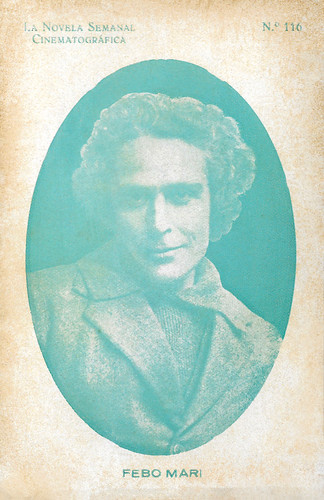
Spanish postcard by La Novela Semanal Cinematografica, no. 116.
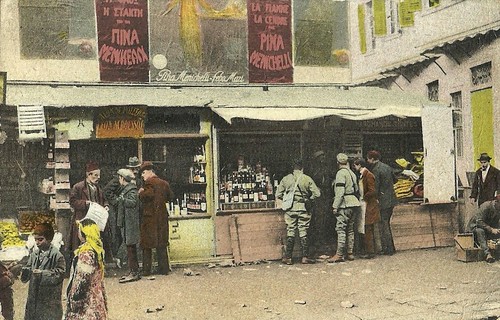
Italian postcard by IPA CT Autocromo. Photo: Henri Manuel. Censured at Terni, 10 October 1917. Caption on the back: Poor shops are still doing business. Soldiers on leave in Saloniki, Greece, during WWI. Above the shops are posters for Il fuoco/The Fire (Giovanni Pastrone, 1915) with Febo Mari, and starring Italian diva Pina Menichelli.

Pina Menichelli and Alberto Nepoti in Tigre reale (Giovanni Pastrone, 1916). Italian postcard by Vettori, Bologna, no. 461.
Artists and their unfaithful models
In 1915, Febo Mari directed Ermete Zacconi in L’emigrante/The Emigrant, in which an old man sells his belongings to find fortune in Argentina while his wife and daughter stay behind. There he encounters so many mishaps, that it led him to return to Italy, reinforce his family ties and leave behind the idea of easy money.
In 1916, he made La gloria/The Glory, a now lost film with a typical plot on artists and their unfaithful models. A sculptor (Mari) protects a poor girl (Valentina Frascaroli) who becomes his model and inspires his masterpiece. However, when he is seriously injured, the girl gets tired of him and dumps him for an old art merchant. During a storm, he saves his masterpiece and thus finds his forces, but when the girl returns, he chases her away and destroys his artwork.
In 1916, Mari returned to Ambrosio, where he directed Cenere/Ashes, based on the novel by Grazia Deledda and starring the stage diva Eleonora Duse in her only film. The film was largely shot on location in Sardinia and in simple interiors, like a Kammerspiel. It deals with Rosalia, a poor mother who leaves her son Anania to his natural father, a well-to-do and married man.
Years after, Rosalia has become destitute. Anania is about to marry a fancy girl (played by Mari’s second wife, Misa Mordeglia Mari, aka Nietta Mordeglia). Though disappointed that his mother had abandoned him in childhood, he wants to invite his mother to the wedding. But the girl dislikes the mother, so the poor woman loses her son once more. She dies, and Anania arrives too late.
Contrasting Mari’s rather heavy gesticulation, Duse showed more restraint, fitting to her reputation for Scandinavian-like acting on stage. A tinted nitrate print at the George Eastman House was used for the colour restoration of the film by the Cineteca del Friuli and the Cineteca Sarda, which had its premiere in 1992 at the Giornate del Cinema Muto.
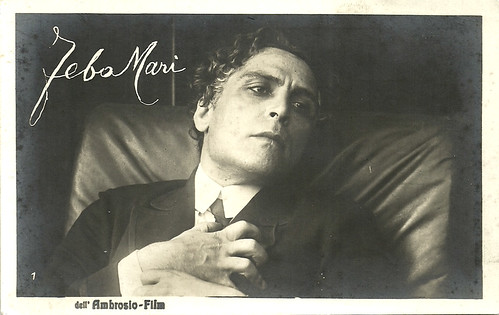
Italian postcard by La Rotofotografica, no. 1. Photo: Ambrosio-Film.

Italian postcard by Fotocelere, no. 127. Photo: Unione Cinematografia Italiana, Roma.
The romance of a faun
In 1917, Febo Mari directed Il Fauno/The Faun, a reverse Pygmalion-themed film starring Mari’s wife, Nietta Mordeglia, as a model who is neglected by her husband, a sculptor (Vasco Creti). She dreams that the marble faun her husband has made (Febo Mari) becomes alive and they fall in love.
A rich female collector (Helena Makowska) buys the statue but underway it falls from a cart and becomes alive once more. The model and the faun live their romance in nature until a jealous hunter (Oreste Bilancia) shoots him and he becomes stone once more. A tinted copy of the film was found and restored.
In the late 1910s, Mari continued to direct various films at Ambrosio: Rose vermiglie/Ruby Roses (1917) with Italia Almirante Manzini, Tormento/Torment (1917) with Helena Makowska, Ercole/Hercules (1918) with Gigetta Morano, and the epic Attila (1918) with Mari, Nietta Mordeglia, Ileana Leonidoff and Maria Roasio.
Subsequently, he founded his own company, Mari Film, in 1918. He directed a few films for this company with Nietta Mordeglia as the female protagonist or antagonist. These films included... e dopo?/And after...? (1918), L’orma/The Footprint (1919), Giuda/Judah (1919), and Casa di bambola/A Doll's House (1919) after Henrik Ibsen's play.
In collaboration with Roberto Roberti, Mari made Maddalena Ferat (1920) starring Francesca Bertini, the period piece Triboulet (1923) with Umberto Zanuccoli in the title role, and La torre di Nesle/The Tower of Nesle (1925), with action hero Celio Bucchi. La Torre di Nesle was Mari’s last film direction, but he continued to act in the film. He appeared in the late silent films Mese mariano/The Month of Mary (Ubaldo Pittei, 1929) and Assunta Spina (Roberto Roberti, 1930), in which he played Michele opposite Rina De Liguoro as Assunta.

Italian postcard by G.B. Falci, Milano. Elena Sangro in Triboulet (Febo Mari, 1923).
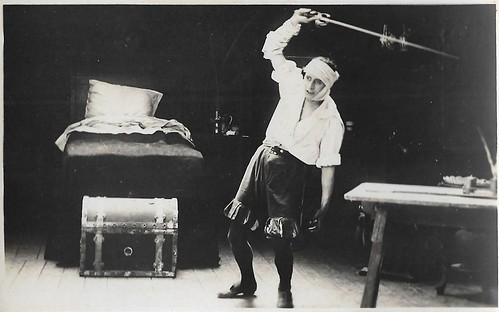
Italian postcard by G.B. Falci, Milano. Photo: Fotominio. Umberto Zanuccoli in the title role of the period piece Triboulet (Febo Mari, 1923), 1th and 2nd episode.

Italian postcard by G.B. Falci, Milano. Photo: Fotominio. Umberto Zanuccoli in the title role of the period piece Triboulet (Febo Mari, 1923), 5th and 6th episode.
Radio days
In the sound era, in the 1930s, Febo Mari’s film parts were scarce. He was the billionaire in the Italian version of the multi-language film I tre desideri/The Three Wishes (Kurt Gerron, Giorgio Ferroni, 1937), a Milanese theatre director (!) in Giuseppe Verdi/The Life of Giuseppe Verdi (Carmine Gallone, 1938), and he had a supporting part in Lotte nell'ombra/Battles in the Shadow (Domenico Gambino, 1939).
In the late 1930s, Mari was active in radio plays, both comedy and drama, at the Roman radio studio EIAR. Febo Mari died in Rome in 1939. He was 55. He had played his last film part in Il conte di Brechard/The Count of Brechard (Mario Bonnard, 1940), starring Amedeo Nazzari. The film was released after Mari’s death.
Febo and Misa Mordeglia Mari's daughter was actress Isa Mari. Isa Mari also worked as a script supervisor for a.o. Federico Fellini’s La dolce vita (1960) and was the author of the novel Nella città l’inferno (Hell in the City).
Her novel about women in prison was adapted by director Renato Castellani as Nella città l’inferno/...and the Wild Wild Women (1959) starring Anna Magnani and Giulietta Masina.
The Fondo Misa e Febo Mari, left by Misa Mordeglia Mari, can be consulted at the Centro Studi del Teatro Stabile di Torino. This contains letters, notes dealing with film projects, telegrams by Eleonora Duse, letters by Arturo Ambrosio and Grazia Deledda, etc. In 1998, Nino Genovese published the study 'Febo Mari'.
Italian postcard for the Ambrosio film Attila (1918) by Febo Mari and starring himself in the title role. Translation caption: The torture of a girl by orders of Attila.
Italian postcard for the Ambrosio film Attila (Febo Mari, 1918). Translation caption: Saint Genevieve announces that Attila is retreating.
Italian postcard for the Ambrosio film Attila (Febo Mari, 1918). Translation caption: The Huns advance while killing and burning all over the Venetian plains.
Sources: Sempre in penombra/ (Italian), Aldo Bernardini/Vittorio Martinelli (Il cinema muto italiano - Italian), Torino citta del cinema (Italian), Wikipedia (Italian and Spanish), and IMDb.
This post was last updated on 7 May 2025.
No comments:
Post a Comment